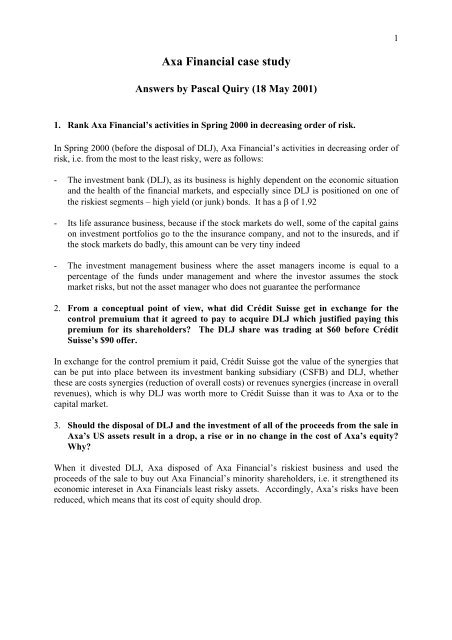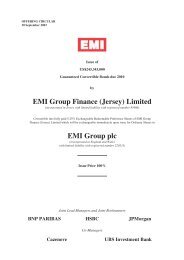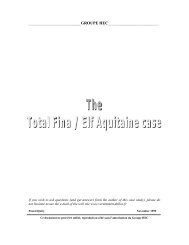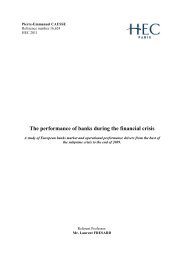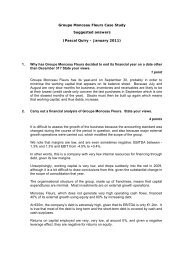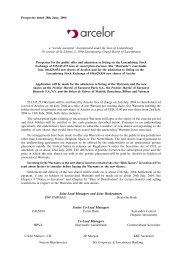Axa Financial case study - Vernimmen
Axa Financial case study - Vernimmen
Axa Financial case study - Vernimmen
Create successful ePaper yourself
Turn your PDF publications into a flip-book with our unique Google optimized e-Paper software.
1<br />
<strong>Axa</strong> <strong>Financial</strong> <strong>case</strong> <strong>study</strong><br />
Answers by Pascal Quiry (18 May 2001)<br />
1. Rank <strong>Axa</strong> <strong>Financial</strong>’s activities in Spring 2000 in decreasing order of risk.<br />
In Spring 2000 (before the disposal of DLJ), <strong>Axa</strong> <strong>Financial</strong>’s activities in decreasing order of<br />
risk, i.e. from the most to the least risky, were as follows:<br />
- The investment bank (DLJ), as its business is highly dependent on the economic situation<br />
and the health of the financial markets, and especially since DLJ is positioned on one of<br />
the riskiest segments – high yield (or junk) bonds. It has a β of 1.92<br />
- Its life assurance business, because if the stock markets do well, some of the capital gains<br />
on investment portfolios go to the the insurance company, and not to the insureds, and if<br />
the stock markets do badly, this amount can be very tiny indeed<br />
- The investment management business where the asset managers income is equal to a<br />
percentage of the funds under management and where the investor assumes the stock<br />
market risks, but not the asset manager who does not guarantee the performance<br />
2. From a conceptual point of view, what did Crédit Suisse get in exchange for the<br />
control premuium that it agreed to pay to acquire DLJ which justified paying this<br />
premium for its shareholders The DLJ share was trading at $60 before Crédit<br />
Suisse’s $90 offer.<br />
In exchange for the control premium it paid, Crédit Suisse got the value of the synergies that<br />
can be put into place between its investment banking subsidiary (CSFB) and DLJ, whether<br />
these are costs synergies (reduction of overall costs) or revenues synergies (increase in overall<br />
revenues), which is why DLJ was worth more to Crédit Suisse than it was to <strong>Axa</strong> or to the<br />
capital market.<br />
3. Should the disposal of DLJ and the investment of all of the proceeds from the sale in<br />
<strong>Axa</strong>’s US assets result in a drop, a rise or in no change in the cost of <strong>Axa</strong>’s equity<br />
Why<br />
When it divested DLJ, <strong>Axa</strong> disposed of <strong>Axa</strong> <strong>Financial</strong>’s riskiest business and used the<br />
proceeds of the sale to buy out <strong>Axa</strong> <strong>Financial</strong>’s minority shareholders, i.e. it strengthened its<br />
economic intereset in <strong>Axa</strong> <strong>Financial</strong>s least risky assets. Accordingly, <strong>Axa</strong>’s risks have been<br />
reduced, which means that its cost of equity should drop.
2<br />
4. Knowing that DLJ was sold on the basis of a 2000 P/E ratio of 18.2, and that the <strong>Axa</strong><br />
<strong>Financial</strong> minority shareholders were bought out on the basis of a P/E ratio of 17.5%,<br />
paid in <strong>Axa</strong> shares which had a 2000 P/E ratio of 26.3, and in cash at an after tax<br />
cost of 5%, was this double transaction earings enhancing or did it dilute <strong>Axa</strong>’s EPS<br />
before depreciation of goodwill Why<br />
A distinction has to be drawn between investment and financing. From an investment point<br />
of view, <strong>Axa</strong> sells assets on the basis of a P/E ratio of 18.2, and reinvests the proceeds from<br />
the sale on the basis of a P/E ratio of 17.5. As the P/E ratio of the assets sold is higher than<br />
the P/E ratio of the assets acquired, this transaction will enhance <strong>Axa</strong>’s earnings per share.<br />
From a financing point of view, <strong>Axa</strong> finances the transaction using <strong>Axa</strong> shares, which have a<br />
P/E ratio of 26.3, and cash at an after tax cost of 5%. The accounting profitability of the asset<br />
acquired in the first year is 1/P/E ratio, i.e. 1/17.5 = 5.7% for an accounting cost of financing<br />
of 1/P/E ratio, i.e. 1/26.3 = 3.8%, for the portion paid in shares, and 5% for the portion paid in<br />
cash, which are both lower than 5.7%. The transaction is thus earnings enhancing from an<br />
accounting point of view.<br />
This double transaction enhances <strong>Axa</strong>’s EPS before depreciation of goodwill.<br />
5. In the insurance sector, practically all analysts look at figures after depreciation of<br />
goodwill. On this basis, the buyout of <strong>Axa</strong> <strong>Financial</strong>’s minority shareholders dilutes<br />
<strong>Axa</strong>’s EPS by around 2%. How do you reconcile this with your answer to question<br />
3 Does this seem logical to you Why<br />
<strong>Axa</strong>'s cost of equity drops following the sale of DLJ, since the risk of its capital employed<br />
decreases (see question 3) and as the amount of <strong>Axa</strong>’s equity is not affected by this<br />
transaction, it is only logical that <strong>Axa</strong>’s EPS should fall, resulting in a lower required return<br />
after the disposal of DLJ.<br />
The dilution of <strong>Axa</strong>’s EPS after the sale of DLJ is perfectly logical. EPS before and after a<br />
transaction (acquisition, disposal, capital increase or reduction, etc.) can only be compared<br />
and serve as a basis for conclusions on the creation or destruction of value, if the level of risk<br />
and growth is the same before and after the transaction in question.<br />
6. Does this double transaction create or destroy <strong>Axa</strong> shareholder value The <strong>Axa</strong><br />
<strong>Financial</strong> minority shareholders were bought out on the basis of net asset value per<br />
share, or $53.50. The <strong>Axa</strong> financial share was trading at $52.25 after the<br />
announcement of the disposal of DLJ and before the announcement of the buyout of<br />
the <strong>Axa</strong> <strong>Financial</strong> minority shareholders.<br />
a) Sale of DLJ<br />
The sale of DLJ creates value for the <strong>Axa</strong> shareholder equal to the amount of the control<br />
premium paid by Crédit Suisse, and which is the counterpart of the synergies that <strong>Axa</strong> was<br />
unable to put into place: 50% (control premium) x $6.9bn (DLJ’s market cap before the sale)<br />
x 60.3% (<strong>Axa</strong>’s stake in <strong>Axa</strong> <strong>Financial</strong>) x 70% (<strong>Axa</strong> <strong>Financial</strong>’s stake in DLJ) = $1.46bn.<br />
b) Buyout of <strong>Axa</strong> <strong>Financial</strong>’s minority shareholders
Excluding the synergies between <strong>Axa</strong> and <strong>Axa</strong> <strong>Financial</strong>, the buyout of the <strong>Axa</strong> <strong>Financial</strong><br />
minority shareholders by <strong>Axa</strong> destroys value equal to the amount of the premium paid<br />
⎛ 53,5 −52,25<br />
⎞<br />
⎜<br />
= 2,4% ⎟soit<br />
2,4% × 18,1Md$ = 434M$ .<br />
⎝ 52,25 ⎠<br />
It could be considered that there is no actual destruction of value, given that <strong>Axa</strong> buys out the<br />
<strong>Axa</strong> minority shareholders on the basis of net asset value, and the premium paid merely sets<br />
off the discount compared with NAV.<br />
On the whole, this double transaction creates value for AXA in the amount of at least 1.45 -<br />
0.434 = $1.120bn.<br />
This illustrates that the “rule” that enhancing EPS = creation of value and diluting EPS =<br />
destruction of value, is a very hard and fast rule, and that it cannot be applied whenever a<br />
financial operation (capital increase or reduction, acquisition, disposal, merger, demerger,<br />
etc.) modifies the risk of the activities (as is the <strong>case</strong> here) or their prospects for growth.<br />
7. What are the circumstances in which the buyout of minority shareholders in the<br />
subsidiaries of a parent company can create value for the shareholders of the parent<br />
company Comment on the size of the premium offered by <strong>Axa</strong> to the <strong>Axa</strong> <strong>Financial</strong><br />
minority shareholders.<br />
The buyout of minority shareholders creates value for the shareholders of the parent company<br />
when:<br />
- The shares in the subsidiary are bought at below their equilibrium value, which in<br />
efficient markets, or when corporate governance is adequate, rarely happens<br />
- Flows between subsidiary and parent company circulate more freely - reduction of tax<br />
inefficiencies, minority shareholders no longer legally able to oppose decisions<br />
- It becomes possible to implement synergies between the parent company and its<br />
subsidiary that previously could not be put in place. Most of the time, they should already<br />
have been implemented<br />
- It leads to the elimination of any discount that the parent company may be trading at due<br />
to its holding company status. A holding company is a company which has minority<br />
stakes in diversified businesses, usually with no control over management, which has a<br />
stake of more than 95% in a single asset in LBO type transactions<br />
<strong>Axa</strong> paid a very small premium (2.4%) which only brings the value of the <strong>Axa</strong> <strong>Financial</strong><br />
share up to the level of net asset value per share. Unsurprisingly, the new synergies between<br />
<strong>Axa</strong> and <strong>Axa</strong> <strong>Financial</strong> should not be very high.<br />
P.S.: <strong>Axa</strong> cannot really be described as a holding company (see definition above).<br />
8. Calculate the change in <strong>Axa</strong>’s beta which results from this double transaction. Use<br />
the following figures:<br />
<strong>Axa</strong> <strong>Financial</strong>’s beta before the operation: 1.32<br />
DLJ’s beta: 1.92<br />
<strong>Axa</strong> <strong>Financial</strong>’s market capitalisation: $18.1bn<br />
DLJ’s market capitalisation before operation: $6.9bn<br />
3
4<br />
<strong>Axa</strong>’s market capitalisation before operation:<br />
<strong>Axa</strong> <strong>Financial</strong>’s stake in DLJ: 70%<br />
<strong>Axa</strong>’s stake in <strong>Axa</strong> <strong>Financial</strong>: 60.3%<br />
$58bn<br />
All of the proceeds of the sale of DLJ are reinvested in buying out <strong>Axa</strong> <strong>Financial</strong>'s<br />
minority shareholders, since the amounts correspond exactly after the sale of the<br />
Crédit Suisse shares received.<br />
Since all of the proceeds of the sale of DLJ by <strong>Axa</strong> <strong>Financial</strong> are used to buy out the <strong>Axa</strong><br />
<strong>Financial</strong> minority shareholders, the change in <strong>Axa</strong>'s beta resulting from this double<br />
transaction is equal to the difference in beta between that of DLJ and that of <strong>Axa</strong> <strong>Financial</strong>'s<br />
other assets multiplied by the relative share of DLJ’s stake in the value of <strong>Axa</strong>.<br />
i.e.: share of DLJ in <strong>Axa</strong>: $6.9bn (DLJ’s market cap before the sale) x 60.3% (<strong>Axa</strong>’s stake in<br />
<strong>Axa</strong> <strong>Financial</strong>) x 70% (<strong>Axa</strong> <strong>Financial</strong>’s stake in DLJ) / $58bn (<strong>Axa</strong>’s market cap) = 5%.<br />
ββ <strong>Axa</strong> <strong>Financial</strong> = β DLJ × share of DLJ in AF + β other AF assets × ((1 – share of DLJ in AF)<br />
70% × 6,9<br />
⎛ 70% × 6,9 ⎞<br />
1,32=<br />
1,92×<br />
+βautresacti fsAF×<br />
⎜1−<br />
⎟d'oùβautresactifsAF<br />
= 1,1<br />
18,1<br />
⎝ 18,1 ⎠<br />
∆ β<strong>Axa</strong><br />
= 5% × ( 1,1 −1,92) = − 0, 04<br />
<strong>Axa</strong>’s β should thus fall by 0.04 after the sale of DLJ and the reinvestment of the proceeds of<br />
the sale in <strong>Axa</strong> <strong>Financial</strong>’s other assets.<br />
9. If the market risk premium were 3%, what would the impact be of this double<br />
operation of the cost of <strong>Axa</strong>’s equity<br />
If <strong>Axa</strong>’s β falls by 0.04 and the risk premium is 3%, using the CAPM formula (r = rf + β(rm –<br />
rf)), the cost of <strong>Axa</strong>’s equity should fall by 3% x 0.04 = 0.12%.<br />
10. Does this mean that in the future, <strong>Axa</strong> should require a rate of return on new<br />
investments that factors in this new cost of equity Why<br />
No, it is only the return on equity of the whole <strong>Axa</strong> group that has fallen by 0.12%, and this<br />
rate is only used to appreciate the return on equity of the <strong>Axa</strong> group as a single entity.<br />
Otherwise, on each individual investment made by <strong>Axa</strong>, the required return on equity on these<br />
investments does not factor in the risk of the investment and the related financial structure.<br />
The fall in the cost of <strong>Axa</strong>'s equity resulting from the sale of DLJ and the reinvestment of the<br />
proceeds of the sale in <strong>Axa</strong> <strong>Financial</strong>'s other assets, does not impact on the required rate of<br />
return on <strong>Axa</strong>'s various investments.


